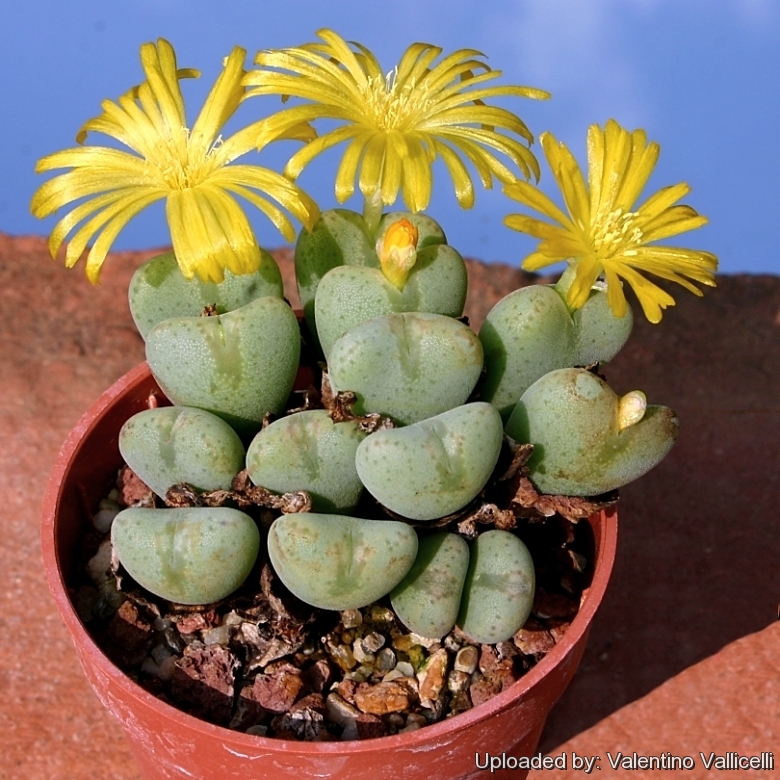
Conophytum meyeri Photo by: Valentino Vallicelli
JE1776 It is a fascinating plant with showy daisy-like yellow flowers in autum .
Origin and Habitat: Western Richtersveld, between Kleinsee and Lekkersing. Northern Cape, South Africa.
Altitude: 130-980 m.
Habitat: It grows in the succulent Karoo often under shrubs in crevices on smoothly sculpted granite, quartzite or gneiss rock formations.
Synonyms:
See all synonyms of Conophytum meyeri
back
Accepted name in llifle Database:Conophytum meyeri N.E.Br.Gard. Chron. III, 78: 484 1925.Synonymy: 22
back
Common Names include:
RUSSIAN (Русский): Конофитум Мейера
Description: Conophytum meyeriSN|18940]]SN|18940]] is a dwarf perennial leaf-succulent, that divide quite freely forming fairly large mats or domes of greyish-green bodies with nice yellow blooms.
Stem: It is almost stemless (branches subterranean) or branch aerially.
Bodies (Paired leaves): Firm, about 8-13(-50) mm long and 5-15 mm broad, and 5-10 mm thick, inverted cordiform to obovoid, slightly and partially fused or slightly "two-lobed" (The leaves are imperfectly fused) not or but slightly keeled at the apex, pale grey-green to glaucous to greyish in colour. Epidermis is marked with darker dots (papillate), not window or window appears on a strip on either side of the fissure. Fissure papillate. The densely spotted thick sheaths are papery to leathery.
Flowers: Solitary, showy, daisy-like, scentless, early diurnal, with a prominent perianth tube. Petals bright yellow.
Blooming season: Autumn.
Subspecies, varieties, forms and cultivars of plants belonging to the Conophytum meyeri group
 Conophytum meyeri N.E.Br.: has cordiform to obovoid, greyish-green bodies with nice yellow blooms.
Conophytum meyeri N.E.Br.: has cordiform to obovoid, greyish-green bodies with nice yellow blooms. Conophytum nanum Tischer: has slightly smaller bodies, but in all other respects the same as the type.
Conophytum nanum Tischer: has slightly smaller bodies, but in all other respects the same as the type.
Bibliography: Major references and further lectures
1) James Cullen, Sabina G. Knees, H. Suzanne Cubey “The European Garden Flora Flowering Plants: A Manual for the Identification of Plants Cultivated in Europe, Both Out-of-Doors” Cambridge University Press, 11/Aug./2011
2) Raimondo, D., von Staden, L., Foden, W., Victor, J.E., Helme, N.A., Turner, R.C., Kamundi, D.A. and Manyama, P.A. 2009. “Red List of South African Plants.” Strelitzia 25. South African National Biodiversity Institute, Pretoria.
2) Hammer, S. 1993. “The Genus Conophytum - A Conograph.” Succulent Plant Publications, Pretoria.
3) Hammer, S. 2002. “Dumpling and His Wife: New Views of the Genus Conophytum.” East Anglia Engraving Creative Colour Ltd, Norwich, England.
4) Heidrun E. K. Hartmann (2001) “Aizoaceae A – E” Springer
5) Colin Paterson-Jones “Wild Flowers of South Africa” Struik, 2006
6) Margaret J. Martin, Peter Richard Chapman “Succulents and their cultivation” Scribner, 1978
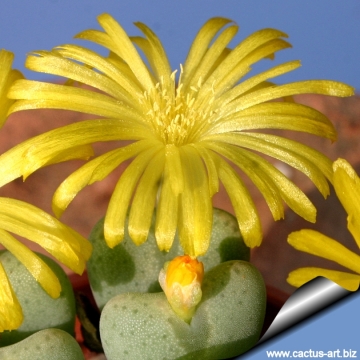 Conophytum meyeri Photo by: Cactus Art
Conophytum meyeri Photo by: Cactus Art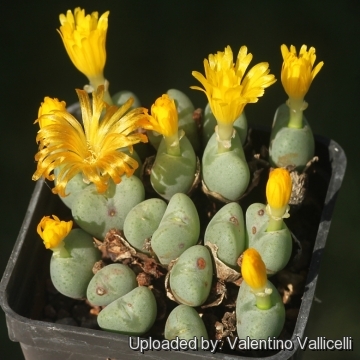 Conophytum meyeri Photo by: Valentino Vallicelli
Conophytum meyeri Photo by: Valentino Vallicelli Conophytum meyeri Photo by: Cactus Art
Conophytum meyeri Photo by: Cactus Art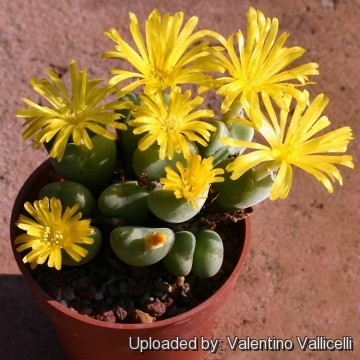 Conophytum meyeri Photo by: Valentino Vallicelli
Conophytum meyeri Photo by: Valentino Vallicelli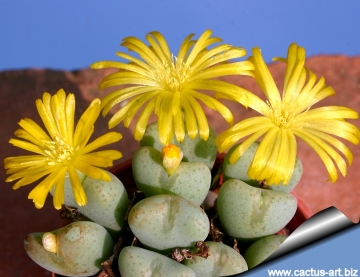 Conophytum meyeri Photo by: Cactus Art
Conophytum meyeri Photo by: Cactus Art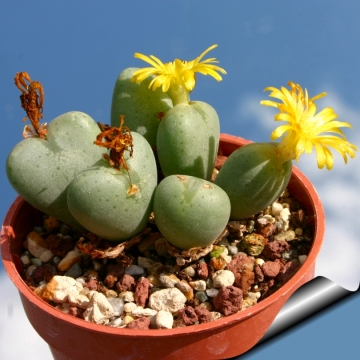 Conophytum meyeri Photo by: Cactus Art
Conophytum meyeri Photo by: Cactus Art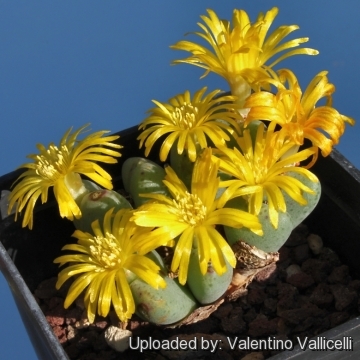 Conophytum meyeri Photo by: Valentino Vallicelli
Conophytum meyeri Photo by: Valentino Vallicelli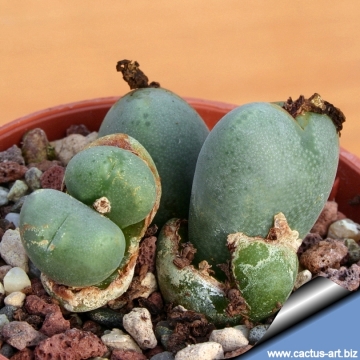 Conophytum meyeri Photo by: Cactus Art
Conophytum meyeri Photo by: Cactus ArtCultivation and Propagation: It is a "winter" grower which is most active from late winter until later spring and heading for summer dormancy, but in favourable growing conditions it keeps going over the summer too and doesn't need particular care. All the forms of Conophytum meyeriSN|18940]]SN|18940]] have the advantage of ease of growth.
Soil: Requires good drainage as it it is prone to root rot. It can grows outdoor in sunny, dry, rock crevices (protection against winter wet is required) It can also be cultivated in alpine house, in poor, drained soil.
Watering: It requires little water; otherwise its epidermis breaks (resulting in unsightly scars). Water minimally in summer, (only when the plant starts shrivelling), but it will generally grow even in summer if given water. Water regularly in winter after the previous year's leaves have dried up. Requires good drainage.
Fertilization: Feed it once during the growing season with a fertilizer specifically formulated for cactus succulents (poor in nitrogen), including all micro nutrients and trace elements diluted to ½ the strength recommended on the label. It thrives in poor soils and need a limited supplies of fertilizer to avoid the plants developing excess vegetation, which is easily attacked by fungal diseases.
Exposure: Keep cool and shaded in summer, it needs full sun or light shade.
Temperature: Hardy to -2°C. Ensure a very good ventilation.
Repotting: Avoid to repot frequently. This plant may stay in the same pot for many years.
Uses: Container, rock garden.
Pests and diseases: It is vulnerable to mealybugs and rarely scale.
Propagation:: It can be reproduced both by cuttings and seeds. Take the cutting from a grown-up mother plant. Each cutting must contain one or more heads along with a fraction of root. It is easily propagated by seed.



















